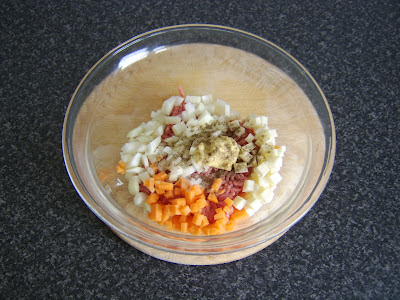 |
| Easy beef and vegetable pasty |
Pasties are unquestionably every bit as versatile as pies, in terms of the different fillings you can incorporate. While Cornish pasties may be what most people automatically think of when they hear the word pasty, it is important to realise - if you are to truly get the greatest enjoyment from this delicious food creation - that a pasty is simply a filling of some type encased in folded pastry and baked in the oven. You can even make sweet pasties, as well as savoury. This really easy and cheap pasty idea is based on the Cornish pasty but the filling is minced beef rather than chopped steak and the vegetables are considerably more finely chopped for a smoother eating experience. Why not give this idea a go as a really inexpensive and simple to prepare dinner some night?
 |
| Principal ingredients for beef and vegetable pasty |
Ingredients per Pasty
6oz minced or ground beef
1/2 medium carrot, peeled and finely diced
1/2 medium parsnip, peeled and finely diced
1 small onion, peeled and finely diced
1 tsp Dijon mustard (optional)
Salt and freshly ground black pepper
1/2 lb premade puff pastry
Beaten egg for glazing
Butter for greasing baking tray
 |
| Finely diced vegetables for beef pasty |
Directions
Put your oven on to preheat to 400F/200C.
Put the beef, vegetables and mustard in to a large bowl and season. Stir very well to combine. You can use a spoon here but you may find it easier to use your hand.
 |
| Pasty filling ingredients are mixed together in a bowl |
Roll out the pastry on a dry, floured surface to a square of just over 13 inches. Use a 13" dinner plate to cut a circle in the pastry.
 |
| A large dinner plate is used as a template to cut the pastry for the pasty |
It is virtually essential at this stage to use your hands to position and form the filling on the pastry. It should go on one half only, with a 1 inch border around the edge. Try to make the filling layer thickest towards the centre, slowly sloping down towards the edges.
 |
| Pasty filling is carefully shaped on rolled pastry |
Glaze the border of the filled pastry half before folding the empty half carefully over the top and lightly pressing to seal.
 |
| Pasty is folded over |
Crimp the pasty around the edges and lift it carefully on to a baking sheet or tray, lightly greased with butter.
 |
| Pasty is carefully crimped around the edges |
Glaze the pasty well with more beaten egg and make a slit in the centre for steam to escape as it cooks. Put it on to the oven for thirty-five minutes until beautifully risen and golden in colour.
 |
| Prepared pasty is ready for the oven |
When the pasty comes out of the oven, you should sit it aside to rest for ten to fifteen minutes.
 |
| Cooked and rested pasty is cut in half |
Precisely how you serve the pasty is entirely up to you. It can be made to be a substantial meal for one person or form a meal for two with further accompaniments.
Below are just a couple of very simple serving accompaniments you may wish to consider...
 |
| Beef and vegetable pasty with baked beans |
 |
| Beef and vegetable pasty with baked beans and tomato sauce |
No comments:
Post a Comment